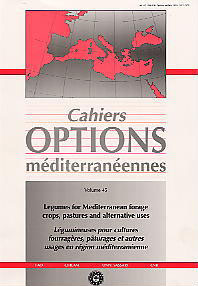| Article précédent | p. 113-126 | Article suivant |
Agronomic aspects of forage legumes: management and forage quality
Forage legumes are essential components of the Mediterranean grazing resources because they make 20 per cent or more of the total number of species present. Several factors however such as adverse climatic and edaphic conditions as well as irrational grazing may substantially reduce or even eliminate them. In order to increase their presence in rangelands various management interventions are needed including fertilization, especially with phosphate fertilizer, seeding, planting, chiefly for woody species and prescribed burning. In most cases, however, best results can be achieved if proper grazing is combined with a balanced fertilization. The majority of legumes, especially the self-reseeding ones, can withstand heavy grazing but they need protection during the flowering period in order to produce seeds and replenish the seed reserves. The nutritive value of legumes is high thus contributing to a nutritious and balanced diet.
- [ Afficher ]
- [ Télécharger ]
- [ Exporter la citation ]
Vous pouvez télécharger la citation au format :
- [ Imprimer ]
-
Mots-clés
FERTILISATION, LEGUMINEUSE FOURRAGERE, PATURAGES, SYSTEME DE PATURAGE, VALEUR NUTRITIVECiter cet article
Papanastasis V.P., Papachristou T.G. Agronomic aspects of forage legumes: management and forage quality. In : Sulas L. (ed.). Legumes for Mediterranean forage crops, pastures and alternative uses . Zaragoza : CIHEAM, 2000. p. 113-126. (Cahiers Options Méditerranéennes; n. 45). 10. Meeting of the Mediterranean Sub-Network of the FAO-CIHEAM Inter-Regional Cooperative Research and Development Network on Pastures and Fodder Crops, 2000/04/04-09, Sassari (Italy). http://om.ciheam.org/om/pdf/c45/00600180.pdf



